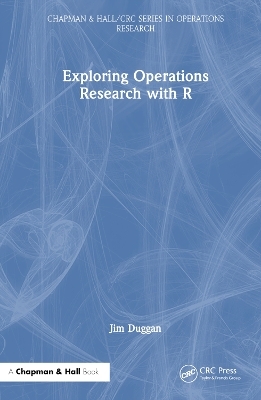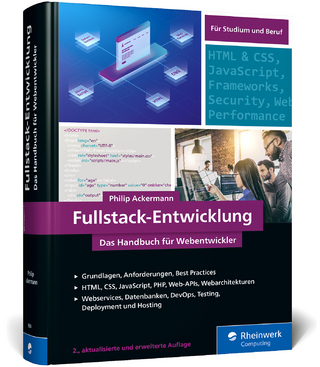
Exploring Operations Research with R
Chapman & Hall/CRC (Verlag)
978-1-032-27754-7 (ISBN)
Exploring Operations Research with R shows how the R programming language can be a valuable tool – and way of thinking – which can be successfully applied to the field of operations research (OR). This approach is centred on the idea of the future OR professional as someone who can combine knowledge of key OR techniques (e.g., simulation, linear programming, data science, and network science) with an understanding of R, including tools for data representation, manipulation, and analysis. The core aim of the book is to provide a self-contained introduction to R (both Base R and the tidyverse) and show how this knowledge can be applied to a range of OR challenges in the domains of public health, infectious disease, and energy generation, and thus provide a platform to develop actionable insights to support decision making.
Features
Can serve as a primary textbook for a comprehensive course in R, with applications in OR
Suitable for post-graduate students in OR and data science, with a focus on the computational perspective of OR
The text will also be of interest to professional OR practitioners as part of their continuing professional development
Linked to a Github repository including code, solutions, data sets, and other ancillary material
Jim Duggan is a Personal Professor in Computer Science at the University of Galway, Ireland. He lectures on R, MATLAB®, and system dynamics, and he is a certified RStudio tidyverse instructor. His research interests are interdisciplinary and focus on the use of simulation and computational methods to support public health policy. You can learn more about his work on R and computation modelling on his GitHub site https://github.com/JimDuggan.
1. Getting Started with R. 1.1. Introduction. 1.2. Exploring R via the RStudio console. 1.3. Calling functions. 1.4. Installing packages. 1.6. Next Steps. 2. Vectors. 2.1. Introduction. 2.2. Atomic Vectors. 2.3. Vectorisation. 2.4. Lists. 2.5. Mini-Case: Two-dice rolls with Atomic Vectors. 2.6. Summary of R Functions from Chapter 2. 2.7. Exercises. 3. Subsetting Vectors. 3.1. Introduction. 3.2. Subsetting Atomic Vectors. 3.3. Subsetting Lists. 3.4. Iteration using Loops, and the if statement. 3.5. Mini-Case: Starwars Movies. 3.6. Summary of R Functions from Chapter 3. 3.7. Exercises. 4. Functions, Functionals and the R Pipe. 4.1. Introduction. 4.2. Functions. 4.3. Passing arguments to functions. 4.4. Error checking for functions. 4.5. Environments and Functions. 4.6. Functionals with lapply. 4.7. Mini-Case: Starwars Movies (Revisited) using Functionals. 4.8. Creating a data processing pipeline using R’s native pipe operator. 4.9. Summary of R Functions from Chapter 4. 4.10. Exercises. 5. Matrices and Data Frames. 5.1. Introduction. 5.2. Matrices. 5.3. Data Frames. 5.4. R functions for processing data frames: subset() and transform(). 5.5. Tibbles. 5.6. Functionals on matrices and data frames. 5.8. Mini-Case 2: A Pipeline for Processing data frames. 5.9. Summary of R Functions from Chapter 5. 5.10. Exercises. 6. The S3 Object System in R. 6.1. Introduction. 6.2. S3 in Action. 6.3. Objects, Attributes and Defining S3 Classes. 6.4. The Generic Function Approach. 6.5. Using an Existing Generic Function. 6.6. Custom-Built Generic Functions. 6.7. Inheritance with S3. 6.8. Mini-Case: Creating a Queue S3 Object. 6.9. Summary of R Functions from Chapter 6. 6.10. Exercises. I. Base R. 7. Visualisation with ggplot2. 7.1. Introduction. 7.2. Two datasets from ggplot2 - mpg and diamonds. 7.3. Exploring relationships with a scatterplot. 7.4. Aesthetic mappings. 7.5. Subplots with Facets. 7.6. Statistical Transformations. 7.7. Themes. 7.8. Adding lines to a plot. 7.9. Mini-Case: Visualising the Impact of Storm Ophelia. 7.10. Summary of R Functions from Chapter 7. 7.11. Exercises. 8. Data Transformation with dplyr. 8.1. Introduction. 8.2. The tidyverse Pipe – magrittr. 8.3. Filtering rows with filter(). 8.4. Sorting rows with arrange(). 8.5. Choosing columns with select(). 8.6. Adding columns with mutate(). 8.7. Summarising observations with summarise(). 8.8. Additional dplyr functions. 8.9. Mini-Case: Summarising total rainfall in 2017. 8.10. Summary of R Functions from Chapter 8. 8.11. Exercises. 9. Relational data with dplyr and tidying data with tidyr. 9.1. Introduction. 9.2. Relational data. 9.3. Mutating joins. 9.4. Filtering joins. 9.5. Tidy Data. 9.6. Making data longer using pivot_longer. 9.7. Making data wider using pivot_wider(). 9.8. Mini-Case: exploring correlations relating to wind energy generation. 9.9. Summary of R Functions from Chapter 9. 9.10. Exercises. 10. Processing data with purr. 10.1. Introduction. 10.2. Iteration using map(). 10.3. Additional map_* functions. 10.4. Iterating over two inputs using map2() and pmap(). 10.5. Integrating purrr with dplyr and tidyr to process tibbles. 10.6. Additional purrr functions. 10.7. Mini-Case: generating linear models from the mpg dataset. 10.8. Summary of R Functions from Chapter 10. 10.9. Exercises. 11. Shiny. 11.1. Introduction. 11.2. Reactive Programming. 11.3. Example one: hello shiny. 11.4. Example two: squaring an input number. 11.5. Example three: exploring a weather station. 11.6 Example four: comparing two weather stations. 11.7. Example five: creating a scatter plot. 11.8 Example six: improving design by adding reactive expressions. 11.9. Summary of R Functions from Chapter 11. 11.10. Exercises. II. The tidyverse and Shiny. 12. Exploratory Data Analysis. 12.1. Introduction. 12.2. Exploratory Data Analysis. 12.3 Identifying species of iris using plant measurements. 12.4. Exploring electricity demand in Victoria, Australia. 12.5. Exploring housing values in the Boston suburbs. 12.6. Exploring passenger survival chances on board the Titanic. 12.7. Exploring the effect of wind direction on winter temperatures in Ireland. 12.8. Summary of R Functions from Chapter 12. 13. Linear Programming. 13.1. Introduction. 13.2. Linear Programming - An overview. 13.3. The Reddy Mikks example. 13.4. Exploring a two-variable decision space using R. 13.5. A Graphical Solution to the Reddy Mixx Problem. 13.6. lpSolve: Generating Optimal Solutions in R. 13.7. Sensitivity Analysis using lpSolve. 13.8. Summary of R Functions from Chapter 13. 14. Agent Based Simulation. 14.1. Introduction. 14.2. Networks and the igraph package. 14.3 Agent Design - The Adopter Marketing Problem. 14.4. Simulator Design and Data Structures. 14.5. Simulation Code. 14.6. Summary of R Functions from Chapter 14. 15. System Dynamics. 15.1. Introduction. 15.2. Stocks, Flows and Feedback. 15.3. deSolve. 15.4. The Susceptible-Infected-Removed Model. 15.5. The Susceptible-Infected-Recovered-Hospital Model. 15.6. Policy Exploration of the SIRH Model using Sensitivity Analysis. 15.7. Summary of R Functions from Chapter.
| Erscheinungsdatum | 23.05.2024 |
|---|---|
| Reihe/Serie | Chapman & Hall/CRC Series in Operations Research |
| Zusatzinfo | 36 Line drawings, color; 36 Illustrations, color |
| Sprache | englisch |
| Maße | 156 x 234 mm |
| Gewicht | 880 g |
| Themenwelt | Mathematik / Informatik ► Informatik ► Programmiersprachen / -werkzeuge |
| Mathematik / Informatik ► Informatik ► Software Entwicklung | |
| Mathematik / Informatik ► Informatik ► Theorie / Studium | |
| Mathematik / Informatik ► Mathematik | |
| Technik ► Umwelttechnik / Biotechnologie | |
| ISBN-10 | 1-032-27754-8 / 1032277548 |
| ISBN-13 | 978-1-032-27754-7 / 9781032277547 |
| Zustand | Neuware |
| Informationen gemäß Produktsicherheitsverordnung (GPSR) | |
| Haben Sie eine Frage zum Produkt? |
aus dem Bereich


